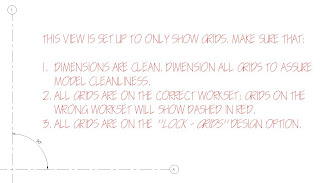Grids are pretty important in ensuring model cleanliness; we all rely on their accuracy when we work on our models, yet they’re just so easy to nudge, and we may not realize they’re no longer accurate. Even worse, a modeler may not care as much about model precision and figure that 90.27 degrees or 20’-0 127/256” is good enough. Once the grids are off, it could take days before this is discovered, and even longer to repair the damage across all disciplines. It’s a real snowball effect.
That’s why I feel it’s important to set up a grid view early in the project, or even better, make it part of your template. This grid view isolates all grids in the model and quickly points out any errors. The grid view monitors spacing & rotation, worksets and locking of grids; of course, it can only be effective if monitored repeatedly by the BIM manager.
For clarity, I’ve set the view scale to 1/32” and am using the following graphics settings:
- Model Categories:
hide all, except for a single construction line type
- Annotation Categories:
hide all, except for dimensions, grids and text notes
- Analytical Model Categories:
uncheck ‘Show analytical model categories in this view’
- Imported Categories:
uncheck ‘Show imported categories in this view’
- Filters:
create a ‘Grids - on wrong workset’ view filter and set the projection lines to be dashed red
- Worksets:
Set all worksets to ‘Show’
- Revit Links:
Leave all linked models turned on and set them to halftone
Now that we have a clean view, we can dimension all grids and quickly spot any inaccuracies; this can only be effective if our precision settings are set correctly. See my post on unit settings and dimensions here.
Next, because we set up a view filter earlier, we can easily identify those grids that are on the wrong workset.
Lastly, I add all grids to a dedicated design option called ‘LOCK - Grids’. This requires that making adjustments to grids is done as a conscious act, and not by mistake. You may get some resistance to this step, but it’s worth the extra step.




No comments:
Post a Comment